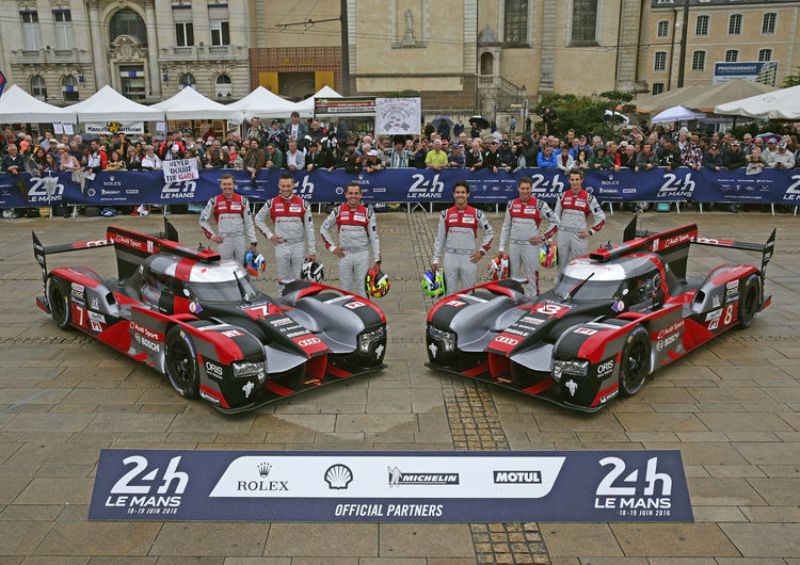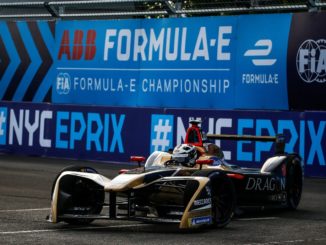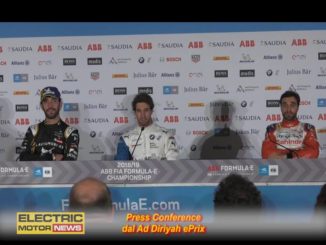24h Le Mans 2016
Fino ad oggi otto vittorie a Le Mans con la tecnologia TDI
Distanza record imbattuta fino ad oggi
Il consumo di carburante ridotto del 46 per cento
Fonte: Audi Motorsport
Le Mans, Francia. 15 Giugno 2016. Audi ha fatto la storia di Le Mans. Nel 2006, il marchio premium è diventato il primo costruttore a vincere quella che è probabilmente la più dura gara di durata al mondo con un motore diesel. Il 2016 segna il decimo anniversario di questo risultato. Oggi, il motore TDI è più efficiente che mai e parte di un molto complesso propulsore diesel-ibrido. Mai prima d’ora una macchina da corsa Audi LMP1 era stata così potente e di consumo contenuto di carburante come l’attuale Audi R18.
La rivoluzione, letteralmente, è venuta tranquillamente. L’ultraveloce e potente TDI è stato annunciato un decennio fa con un suono che era insolito anche alle orecchie degli esperti. L’Audi R10 TDI ha corso in tutto il circuito in modo tanto silenzioso da essere quasi impercettibile.
“Ad alta velocità, anche il rumore del vento era più forte di quella del motore”, ricorda la leggenda di Le Mans Tom Kristensen che, con nove vittorie, è il leader della lista vincitori della gara di 24 ore di tutti i tempi. Guidare e spostarsi a seconda del livello sonoro a partire dal 2006 è stata la storia della macchina da corsa LMP1.
 Tecnologicamente, Audi Sport in preparazione per la stagione 2006, ha vinto la sua sfida più grande fino ad oggi. Il motore V12 TDI non solo ha significato un nuovo propulsore.
Tecnologicamente, Audi Sport in preparazione per la stagione 2006, ha vinto la sua sfida più grande fino ad oggi. Il motore V12 TDI non solo ha significato un nuovo propulsore.
“Abbiamo dovuto elaborare un nuovo concetto per l’intera macchina da corsa”, dice il capo di Audi Motorsport Wolfgang Ullrich. “Dalle proporzioni della macchina da corsa e la sua distribuzione dei pesi al flusso d’aria, il fabbisogno di raffreddamento di aria e la trasmissione di potenza, tutto era nuovo, come coppia e potenza che hanno superato tutto ciò che avevamo precedentemente conosciuto.”
Audi Sport ha testato il motore diesel per Le Mans, in collaborazione con il team di sviluppo pre-produzione e produzione di AUDI AG. L’unità da 5,5 litri e dodici cilindri per l’uso nelle competizioni è stato il primo motore diesel di Audi con un blocco cilindri in alluminio. L’Audi R10 TDI ha completato la sua implementazione iniziale sulla pista italiana di Misano il 29 novembre 2005. Esattamente 200 giorni dopo, la vettura sportiva con motore diesel ha gareggiato nelle 24 Ore di Le Mans 24 e ha vinto. Nel mezzo, 30.000 chilometri di test, più altri 1.500 ore di prova del motore V12 TDI sui dinamometri.. Frank Biela / Emanuele Pirro / Marco Werner (D / I / D) hanno tagliato il traguardo dopo 380 giri come vincitori dopo aver percorso 5.187 chilometri in gara. Nei due anni successivi, il motore TDI da Ingolstadt e Neckarsulm è stato di nuovo è in testa contro la concorrenza agguerrita dei diesel in entrambe le occasioni.
Nel 2010, Audi ha raggiunto il seguente grande passo con la R15 TDI. Il suo motore V10 TDI ha sostituito la precedente unità a dodici cilindri. E’ stato di 100 millimetri più corto, il dieci per cento più leggero e con l’open-cockpit ha avuto una nuova performance superiore. Timo Bernhard / Romain Dumas / Mike Rockenfeller (D / F / D) hanno percorso 5,410.713 chilometri in 397 giri a Le Mans. Con questo, hanno rotto un record di 39 anni prima, da un’epoca in cui non c’erano le chicane a rallentare il ritmo sul rettilineo Hunaudières. In un arrivo in parata, le Audi R15 TDI ha conquistato un uno-due-tre. Per la prima volta il V10 TDI da 5,5 litri ha utilizzato due turbocompressori con turbina a geometria variabile (VTG), che ha migliorato la reattività del motore.
La Audi R18 TDI, ha inaugurato una nuova era nel 2011. Un innovativo, compatto e molto efficiente motore V6 TDI ora alimenta la vettura sportiva da cabina di guida chiusa. Per ridurre in modo significativo i consumi e aumentare la rilevanza della produzione dal ridimensionamento, la cilindrata del motore è diminuita da 3,7 litri ad 1,8 litri. Le bancate dei cilindri con un angolo di 120 gradi racchiudevano il lato scarico – in altre parole i collettori di scarico si trovavano anche dentro la configurazione V. Un singolo turbocompressore a doppio flusso è stato alimentato dal gas di scarico di entrambe le bancate e il suo compressore era di un design a doppio flusso, che ha ben diretto l’aria fresca attraverso due intercooler nei collettori di aspirazione sulla parte esterna.
I guadagni di efficienza espresse in cifre compatte: nell’era diesel dal 2006 al diametro della flangia dell’aria è diminuito del 34 per cento, la pressione di carico è stata ridotta del 4,7 per cento e la cilindrata di quasi il 33 per cento. La potenza assoluta invece è scesa da più di 478 kW (650 CV) a circa 360 kW (490 CV), in altre parole del 24 per cento. Di conseguenza, la potenza per litro è aumentata da 87 kW (118 CV) nel 2006 a 107 kW (146 CV) nel 2011, pari ad un plus di quasi il 24 per cento. Le pressioni di iniezione elevate degli iniettori da corsa portano a combustione ancora più efficiente. Ora operando a 3.000 bar il motore da corsa era un precursore delle pressioni crescenti delle automobili su strada.
Marcel Fässler / André Lotterer / Benoît Tréluyer (CH / D / F) hanno vinto nel 2011 con la R18 TDI e un anno più tardi con l’e-tron quattro R18 che ha utilizzato un propulsore ibrido per la prima volta. Nel 2013, Loïc Duval / Tom Kristensen / Allan McNish (F / DK / GB) furono vittoriosi a Le Mans con una versione ulteriormente sviluppata della R18 e-tron quattro. A seguito Fässler / Lotterer / Tréluyer nel 2012, erano i vincitori del titolo del Campionato Mondiale Endurance FIA (WEC) del 2013. Nel 2014, i regolamenti di efficienza sono entrate in vigore ed hanno segnato un cambiamento radicale nelle corse. Invece di limitare l’uscita da fattori come l’intasamento del filtro dell’aria o la cilindrata, le limitazioni sono state applicate esclusivamente all’energia. Audi ha ampliato il motore V6 TDI che ha dovuto accontentarsi di circa il 22 per cento in meno di carburante rispetto al suo predecessore a quattro litri di cilindrata. Il trio di Fässler / Lotterer / Tréluyer ha ottenuto la terza vittoria – segnando l’ottava per un motore TDI da Audi a Le Mans.
Per la stagione 2016, i regolamenti hanno ulteriormente ridotto il consumo di energia. Audi ha sviluppato il motore V6 TDI ad un nuovo livello.
“Stiamo utilizzando il concetto di motore per il sesto anno consecutivo. Questo dimostra quanto sia ancora buona l’idea di base”, dice Ulrich Baretzky, Head of Engine Development di Audi Sport. “Grazie all’aumento di efficienza, stiamo compensando la minore quantità di combustibile permessa.”
L’attuale motore V6 TDI consuma 32,4 per cento in meno di carburante rispetto alla prima generazione a partire dal 2011. I progressi compiuti rispetto al 2006 sono ancora più consistenti. Oggi, l’auto da corsa LMP1 Audi con la catena cinematica corrente utilizza il 46,4 per cento in meno di carburante a Le Mans rispetto quello che ha fatto dieci anni prima. Nonostante questo, raggiunge tempi che sono da 10 a 15 secondi migliori di quelli di dieci anni fa. Tutto questo è possibile grazie ai singoli passi che sono stati fatti, in particolare nei settori di aerodinamica, leggerezza e propulsore.
In English
Audi to celebrate ten years of TDI at Le Mans
24h Le Mans 2016
Eight Le Mans victories with TDI technology to date
Distance record unbroken to date
Fuel consumption reduced by 46 percent
Source: Audi Motorsport
Le Mans, France. 15th June 2016. Audi has made history at Le Mans. In 2006, the premium brand became the first manufacturer to win what is arguably the world’s toughest endurance race with diesel power. 2016 marks the tenth anniversary of this achievement. Today, the TDI engine is more efficient than ever before and part of a highly complex diesel-hybrid powertrain. Never before has an Audi LMP1 race car been as powerful and fuel-efficient as the current Audi R18.
The revolution, literally, came quietly. The “higher-further-faster” of TDI power was heralded a decade ago with a sound that was unusual even to the ears of seasoned campaigners. The Audi R10 TDI raced around the circuit so silently that it was near-imperceptible.
“At high speed, even the wind noise was louder than that of the engine,” recalls Le Mans legend Tom Kristensen who, with nine victories, clearly leads the all-time winners’ list of the 24-hour race. Driving and shifting according to the sound level from 2006 on was history in the LMP1 race car.
Technologically, Audi Sport in preparation for the 2006 season, mastered its greatest challenge to date. A V12 TDI engine not only meant a new powertrain.
“We had to come up with a new concept for the entire race car,” says Head of Audi Motorsport Dr. Wolfgang Ullrich. “From the proportions of the race car and its weight distribution to airflow, the cooling air requirement and power transmission everything was new, as torque and output surpassed anything we’d previously known.”
Audi Sport tested the diesel engine for Le Mans in collaboration with AUDI AG’s pre-production and production development. The 5.5-liter twelve-cylinder unit for use in racing was the first Audi diesel engine with an aluminum cylinder block. The Audi R10 TDI completed its initial rollout on the Italian race track at Misano on November 29, 2005. Exactly 200 days later, the diesel-powered sports car competed in the Le Mans 24 Hours and won. In between, 30,000 test kilometers, plus another 1,500 hours of testing the V12 TDI engine on dynamometers, were clocked up. Frank Biela/Emanuele Pirro/Marco Werner (D/I/D) crossed the finish line after 380 laps as the winners having covered 5,187 kilometers in the process. In the two subsequent years, the TDI engine from Ingolstadt and Neckarsulm again came out on top against fierce diesel competition on both occasions.
In 2010, Audi achieved the next major step with the R15 TDI. Its V10 TDI engine replaced the previous twelve-cylinder unit. It was 100 millimeters shorter, ten percent lighter and powered the open-cockpit sports car to a new top performance. Timo Bernhard/Romain Dumas/Mike Rockenfeller (D/F/D) covered 5,410.713 kilometers in 397 laps at Le Mans. With that, they broke a 39-year-old record from an era when no chicanes slowed the pace on the Hunaudières straight. In a formation flight, the Audi R15 TDI clinched a one-two-three win. For the first time its 5.5-liter V10 TDI used two turbochargers with variable turbine geometry (VTG) which improved the engine’s responsiveness.
The Audi R18 TDI ushered in a new era in 2011. An innovative, compact and very efficient V6 TDI engine now powered the closed-cockpit sports car. To significantly reduce consumption and increase production relevance by downsizing, the engine’s displacement decreased by 1.8 to 3.7 liters. The cylinder banks with a 120-degree angle enclosed the exhaust side – in other words the exhaust manifolds were inside the V configuration as well. A single double-flow turbocharger was fed by the exhaust of both banks and its compressor was of a double-flow design as well and directed the fresh air through two intercoolers into the intake manifolds on the outside.
The efficiency gains expressed in compact figures: In the diesel era since 2006 the diameter of the air restrictor decreased by 34 percent, charge pressure was reduced by 4.7 percent and cubic capacity by nearly 33 percent. Absolute power output on the other hand dropped from more than 478 kW (650 hp) to about 360 kW (490 hp), in other words by only 24 percent. As a result, output per liter increased from 87 kW (118 hp) in 2006 to 107 kW (146 hp) in 2011, equating to a plus of nearly 24 percent. The higher injection pressures of the racing injectors lead to even more efficient combustion. Now operating at 3,000 bar the racing engine was a precursor of the rising pressures making their way into the automobile.
Marcel Fässler/André Lotterer/Benoît Tréluyer (CH/D/F) won in 2011 with the R18 TDI and a year later with the R18 e-tron quattro that used a hybrid powertrain for the first time. In 2013, Loïc Duval/Tom Kristensen/Allan McNish (F/DK/GB) were victorious at Le Mans with a further developed version of the R18 e-tron quattro. Following Fässler/Lotterer/Tréluyer in 2012, they were the next title winners in the 2013 FIA World Endurance Championship (WEC). In 2014, efficiency regulations came into effect that marked a radical change in racing. Instead of limiting output by factors such as air restriction or cubic capacity the limitations applied purely to energy. Audi enlarged the V6 TDI engine that had to make do with about 22 percent less fuel than its predecessor to four liters of displacement. The trio of Fässler/Lotterer/Tréluyer achieved the third victory – marking the eighth for a TDI engine from Audi at Le Mans.
For the 2016 season, the regulations have further reduced energy consumption. Audi has developed the V6 TDI engine to a new level once more. “We’re now using the engine concept for the sixth consecutive year. This shows how good the basic idea still is,” says Ulrich Baretzky, Head of Engine Development at Audi Sport. “Due to efficiency increases, we’re compensating for the lower amount of fuel to some extent.”
The current V6 TDI engine consumes 32.4 percent less fuel than the first generation from 2011. The progress made in comparison to 2006 is even more substantial. Today, Audi’s LMP1 race car with the current powertrain uses 46.4 percent less fuel at Le Mans than it did ten years earlier. In spite of this, it achieves lap times that are ten to 15 seconds better than those a decade ago. All this is possible thanks to the individual strides that have been made, particularly in the areas of aerodynamics, lightweight design and powertrain.
no images were found




Commenta per primo